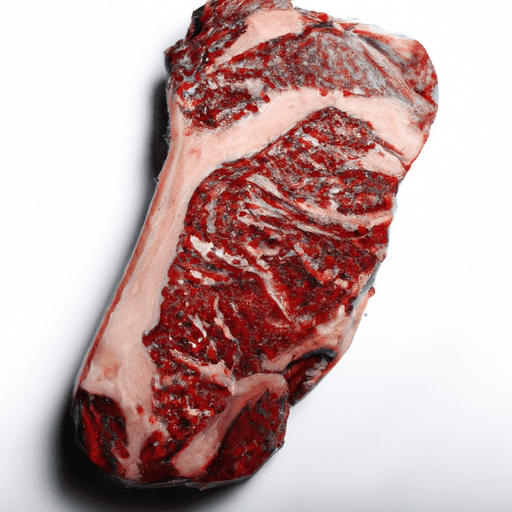The Delectable Delight of Ribeye Steaks
When it comes to mouthwatering cuts of beef, few can rival the succulent and flavorful ribeye steak. Bursting with deliciousness, this steak is a showstopper on any dining table. In this blog post, we will explore the world of ribeye steaks, diving into their taste, common uses in cooking, nutritional value, and uncovering some interesting history and facts along the way.
Taste Sensation on a Plate
Picture this: a juicy and marbled piece of meat, cooked to perfection, with a rich and beefy flavor that melts in your mouth. That’s the essence of a ribeye steak. The generous marbling in the meat ensures a tender and buttery texture, making every bite pure bliss for meat lovers. The ribeye’s exquisite flavor profile is a result of the interplay between the well-distributed fat and the meat’s natural juices, resulting in a burst of savory goodness.
Versatile in the Kitchen
Ribeye steaks are incredibly versatile and can be prepared using various cooking techniques. Whether you prefer grilling, pan-searing, broiling, or even slow-cooking, the ribeye steak will never disappoint. Its high fat content allows for excellent caramelization and browning, lending a beautiful crust to the steak. Seasoned simply with salt and pepper, or elevated with a marinade or rub, the ribeye can take on a wide range of flavors to suit any palate.
These mouthwatering steaks also play a starring role in beef stroganoff, stir-fries, sandwiches, and fajitas. The left-over ribeye can even be used to create flavor-packed steak salads or tantalizing Philly cheesesteaks. The possibilities are truly endless when it comes to this culinary delight.
Nutritional Value
While ribeye steaks are undoubtedly a treat for the taste buds, it’s important to consider their nutritional value. These steaks are an excellent source of high-quality protein, which is essential for building and repairing body tissues. Additionally, ribeye steaks provide important vitamins and minerals, including B vitamins, iron, and zinc. However, it’s important to note that their high fat content means they are also relatively high in calories. As with any indulgence, moderation is key to maintaining a balanced diet.
A Glimpse into History and Facts
Did you know that the ribeye steak is often referred to as the “King of Steaks”? This noble title is well-deserved, given its unparalleled flavor and tenderness. The ribeye comes from the rib primal of the beef, where the muscles are less worked and feature abundant marbling. This rich marbling is what sets the ribeye apart from other cuts, making it a true delicacy.
Another interesting fact is that the ribeye steak is often associated with the prime grade of beef, which is the highest quality designation assigned by the USDA. This grading signifies superior marbling and tenderness, ensuring an unforgettable culinary experience.
In conclusion, the ribeye steak is a culinary treasure that never fails to impress. From its delectable taste and versatile cooking options to its nutritional benefits and fascinating history, this cut of meat is truly a star in the world of fine dining. Next time you’re craving a mouthwatering steak experience, give the ribeye a try and savor every delicious moment.
Ribeye Steaks
Origin: The ribeye steak, also known as a rib eye or rib-eye steak, comes from the rib section of the beef. It is cut from the rib primal of the cow, which is located between the chuck and the short loin.
Common Uses: Ribeye steaks are notably popular for their tenderness and marbling. They are often grilled, broiled, or pan-fried, and their rich flavor makes them a favorite choice for steak lovers. Ribeyes can also be used in dishes like stir-fries, stews, or even sliced thinly for sandwiches.
Nutritional Benefits: Ribeye steaks are a good source of protein, providing about 53 grams of protein per serving (8 ounces, cooked). They also contain essential vitamins and minerals such as vitamin B12, zinc, iron, phosphorus, and selenium. However, ribeye steaks are relatively high in fat and calories compared to leaner cuts of beef.
Unique Properties: One of the distinguishing features of ribeye steaks is the marbling, which refers to the streaks of fat running through the meat. This marbling contributes to the steak’s tenderness and juiciness. Ribeye steaks are also known for their rich flavor, thanks to the combination of intramuscular fat and the meat’s proximity to the bone.
Historical Significance: The rib primal, from which ribeye steaks are cut, has been valued for centuries by various cultures for its flavor and tenderness. In the United States, ribeye steaks gained popularity in the mid-20th century when backyard grilling became a popular cooking method across the country. Today, ribeye steaks are regarded as one of the most popular and prized cuts of beef.




Use the share button below if you liked it.
It makes me smile, when I see it.